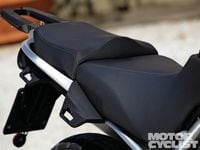Apparently the Italians don’t have a saying that corresponds with “the third time’s a charm,” but after riding Version 3.0 of Moto Guzzi’s Stelvio adventure-tourer, I reckon it’s time they came up with one.
When Guzzi introduced the Stelvio three years ago, it showed potential but was held back by flaws such as poor low-end perform-ance and limited fuel capacity. A year later they tried again, answering some of the original criticisms with a torquier engine and more adventure-oriented accessories.
And now there’s a third version with fresh bodywork that improves styling, weather protection and, most importantly, fuel capacity. The result is a very capable and enjoyable motorcycle. If that’s not a case of “the third time’s a charm,” I don’t know what is!
The biggest change is the redesigned combination of half-fairing and fuel tank. This retains the previous model’s twin headlamps but increases wind protection as well as almost doubling fuel capacity to 8.5 gallons. Our testbike’s most obvious visual difference was the orange “Sienna Earth” paintwork, an alternative to the more restrained white or black.
The 2009-model engine tune (involving a bigger airbox, new cams and revised fuel mapping) that revitalized the 1151cc eight-valve V-twin’s performance below 5000 rpm is the key to the Stelvio’s straight-line performance. This latest version is better still thanks to a revised exhaust system whose twin lambda probes give more accurate fueling than the old model’s simpler, single-probe setup.
Guzzi claims the result is improved fuel consumption as well as more accurate throttle response. The air-cooled, high-cam V-twin has had its valve lifters and oil pump gears redesigned to reduce noise. It also gains ATC (Aprilia Traction Control) similar to that of sister firm Aprilia’s Shiver and Dorsoduro models. Claimed maximum power output of 105 bhp at 7500 rpm is unchanged, though peak torque is up to 83 lb.-ft. and produced 600 rpm earlier at 5800 rpm.
There’s also a new dash with a 12-volt accessory outlet alongside the comprehensive instrument panel. But despite those changes, the Stelvio’s riding position remains the same and felt comfortable and familiar as we left the launch base hotel near Florence in Italy. The air-cooled V-twin pulled with that typically lazy, pleasantly offbeat response from low revs.
Acceleration was strong from below 3000 rpm all the way to 8000 rpm without any significant step. Such was the midrange delivery that I rarely bothered to rev it hard, preferring to short-shift through the gearbox. Given the 35-mpg economy I experienced during my first ride, the bike should be good for 250 miles or more between fill-ups.
The Stelvio is comfortable enough that one wouldn’t want to stop before needing fuel. The windscreen is manually adjustable for height, and provided good protection without too much wind noise. And although the seat is high and might make things tricky if you don’t have long legs, the padding is thick and legroom abundant.
Comfort is further enhanced by well-balanced suspension that glides over bumps and potholes. As with the previous model, I was very impressed by how well such a tall, long-legged bike handled. Even under hard braking the Stelvio didn’t pitch excessively, as most adventure bikes do. The standard ABS worked well, too, and can be deactivated for off-road riding. Not that many owners are likely to venture too far from the pavement on a bike with a curb weight of 617 lbs.
Even with traction control and ABS the Stelvio can’t approach the sophistication of Ducati’s Multistrada 1200, and it’s both heavier and slightly less powerful than its primary rival, the BMW R1200GS. But despite that, I found myself not merely impressed but _charmed _by the Stelvio. It looks good, is respectably quick, handles and brakes very well, and is pleasantly comfortable.
All that was also true of the original Stelvio. The difference this time around is that all of its previous weaknesses have been addressed, while premium features such as ABS and traction control are now included as standard fitment. This third-generation Stelvio is no longer just a more distinctive and quirky alternative to the deservedly popular BMW GS; it’s a legitimate rival that deserves to be taken seriously.
Tech Spec
Evolution
The Stelvio gets upgraded for the third time with more power, improved wind protection and greater fuel range.
Rivals
BMW R1200GS, Ducati Multistrada 1200, Suzuki V-Strom, Triumph Tiger 1050, Yamaha Super Ténéré.
Verdict 4 out of 5 stars.
Incremental improvements add up—this latest Stelvio is a legitimate contender.
Stelvio NTX
The Intrepid Alternative
As before the Stelvio is accompanied by an upmarket NTX model, intended for long distances and rough stuff in the tradition of BMW's R1200GS Adventure. It's outfitted with a larger windscreen, handguards, wire-spoke wheels, a pair of halogen spotlights and burly aluminum side cases. Add the optional satellite navigation system and heated handgrips, and you'd have a mean-looking Moto Guzzi that could tackle just about anything.
Other additions are intended to defend the bike’s vitals in the outback. Tubular-steel engine guards shield the cylinders, running lights and header pipes while an aluminum skidplate guards the sump. Inevitably, these features add weight and cost. With a curb weight of 651 lbs., the NTX is 34 lbs. heavier than the base model, as well as roughly 10 percent more expensive. Like the standard Stelvio, it should be available by winter.


















/cloudfront-us-east-1.images.arcpublishing.com/octane/ITNLTIU5QZARHO733XP4EBTNVE.jpg)
/cloudfront-us-east-1.images.arcpublishing.com/octane/VZZXJQ6U3FESFPZCBVXKFSUG4A.jpg)
/cloudfront-us-east-1.images.arcpublishing.com/octane/QCZEPHQAMRHZPLHTDJBIJVWL3M.jpg)
/cloudfront-us-east-1.images.arcpublishing.com/octane/HXOUJXQWA5HBHGRO3EMJIGFMVI.jpg)

/cloudfront-us-east-1.images.arcpublishing.com/octane/3TIWWRV4JBBOLDVGRYECVVTA7Y.jpg)
/cloudfront-us-east-1.images.arcpublishing.com/octane/KIX5O23D5NAIBGFXBN3327DKZU.jpg)
/cloudfront-us-east-1.images.arcpublishing.com/octane/7GJYDUIPXRGMTMQKN6ONYOLBOU.jpg)
/cloudfront-us-east-1.images.arcpublishing.com/octane/MUQLOVLL2ZDGFH25ILABNBXKTI.jpg)
/cloudfront-us-east-1.images.arcpublishing.com/octane/TNOU5DNE2BC57MFPMGN2EIDXAM.jpg)
/cloudfront-us-east-1.images.arcpublishing.com/octane/GTCXACQGJ5HAPDTGWUQKDEH44E.jpg)
/cloudfront-us-east-1.images.arcpublishing.com/octane/S35YGSEMEZB4BLTDJTSZPF4GLA.jpg)
/cloudfront-us-east-1.images.arcpublishing.com/octane/5UOT6HPX2JFMRJAX6EH45AR4MQ.jpg)
/cloudfront-us-east-1.images.arcpublishing.com/octane/OKWOJWAKP5EP3OACCRRWPCIX2Q.jpg)
/cloudfront-us-east-1.images.arcpublishing.com/octane/2WF3SCE3NFBQXLDNJM7KMXA45E.jpg)
/cloudfront-us-east-1.images.arcpublishing.com/octane/G4MG6OUCJNBSHIS2MVVOTPX65E.jpg)
/cloudfront-us-east-1.images.arcpublishing.com/octane/IIGGWFOTOJGB7DB6DGBXCCMTDY.jpg)
/cloudfront-us-east-1.images.arcpublishing.com/octane/QSTCM6AVEZA5JJBUXNIQ3DSOF4.jpg)
/cloudfront-us-east-1.images.arcpublishing.com/octane/U4I7G625B5DMLF2DVIJDFZVV6M.jpg)
/cloudfront-us-east-1.images.arcpublishing.com/octane/B6XD6LS6IVCQPIU6HXDJSM3FHY.jpg)
/cloudfront-us-east-1.images.arcpublishing.com/octane/ICL63FEDDRDTTMINYICCEYGMDA.jpg)
/cloudfront-us-east-1.images.arcpublishing.com/octane/FCGZHQXRBZFLBAPC5SDIQLVF4I.jpg)
/cloudfront-us-east-1.images.arcpublishing.com/octane/WNOB6LDOIFFHJKPSVIWDYUGOPM.jpg)
